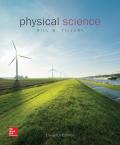
Concept explainers
The premise that the present is the key to understanding the past is called
history.
principle of uniformity.
principles of geology.
philosophy.
From the following options, the premise that the present is the key to understanding the past is known as:
History
Principle of uniformity
Principles of geology
Philosophy
Answer to Problem 1AC
Solution:
Option (b) is correct.
Explanation of Solution
Introduction:
James Hutton introduced the idea of unchanging, catastrophically formed landscapes.
Explanation:
Reason for correct option:
This idea of Hutton led to the concept of uniform changes, i.e., current changes are consistent with changes that take place in the distant past. This frame of reference is called the principle of uniformity.
The principle of uniformity may be represented by a single statement, “the present is the key to the past”.
Hence, option (b) is correct.
Reasons for incorrect option:
History is the study of past. Hence, option (a) is incorrect.
There is no such phrase as principles of geology. Hence, option (c) is incorrect.
Philosophy is the study of meaning, existence and knowledge. Hence, option (d) is incorrect.
Conclusion:
Principle of uniformity is codified by the phrase that the present is the key to understand the past.
Want to see more full solutions like this?
Chapter 19 Solutions
EBK PHYSICAL SCIENCE
Additional Science Textbook Solutions
Principles of Anatomy and Physiology
Fundamentals Of Thermodynamics
Loose Leaf For Integrated Principles Of Zoology
Introductory Chemistry (6th Edition)
- please solve and answer the question correctly. Thank you!!arrow_forward18arrow_forward1. Some 1800 years ago Roman soldiers effectively used slings as deadly weapons. The length of these slings averaged about 81 cm and the lead shot that they used weighed about 30 grams. If in the wind up to a release, the shot rotated around the Roman slinger with a period of .14 seconds. Find the maximum acceleration of the shot before being released in m/s^2 and report it to two significant figures.arrow_forward
- 16arrow_forward11. A small charged plastic ball is vertically above another charged small ball in a frictionless test tube as shown in the figure. The balls are in equilibrium at a distance d= 2.0 cm apart. If the charge on one ball is tripled, find the new equilibrium distance between the balls in cm and report it to the proper number of significant figures.arrow_forward12. The electric field at a point 1.3 cm from a small object points toward the object with a strength of 180,000 N/C. Find the object's charge q, in nC to the proper number of significant figures. k = 1/4πε0 = 8.99 × 10^9 N ∙ m^2/C^2arrow_forward
- 14. When the potential difference between the plates of an ideal air-filled parallel plate capacitor is 35 V, the electric field between the plates has a strength of 670 V/m. If the plate area is 4.0 × 10^-2 m^2, what is the capacitance of this capacitor in pF? (ε0 = 8.85 × 10^-12 C^2/N ∙ m^2)arrow_forward10. A small styrofoam ball of mass 0.500 g is placed in an electric field of 1140 N/C pointing downward. What excess charge must be placed on the ball for it to remain suspended in the field? Report your answer in micro-Coulombs to three significant figures.arrow_forward2arrow_forward
 Horizons: Exploring the Universe (MindTap Course ...PhysicsISBN:9781305960961Author:Michael A. Seeds, Dana BackmanPublisher:Cengage Learning
Horizons: Exploring the Universe (MindTap Course ...PhysicsISBN:9781305960961Author:Michael A. Seeds, Dana BackmanPublisher:Cengage Learning An Introduction to Physical SciencePhysicsISBN:9781305079137Author:James Shipman, Jerry D. Wilson, Charles A. Higgins, Omar TorresPublisher:Cengage Learning
An Introduction to Physical SciencePhysicsISBN:9781305079137Author:James Shipman, Jerry D. Wilson, Charles A. Higgins, Omar TorresPublisher:Cengage Learning AstronomyPhysicsISBN:9781938168284Author:Andrew Fraknoi; David Morrison; Sidney C. WolffPublisher:OpenStax
AstronomyPhysicsISBN:9781938168284Author:Andrew Fraknoi; David Morrison; Sidney C. WolffPublisher:OpenStax
 Foundations of Astronomy (MindTap Course List)PhysicsISBN:9781337399920Author:Michael A. Seeds, Dana BackmanPublisher:Cengage Learning
Foundations of Astronomy (MindTap Course List)PhysicsISBN:9781337399920Author:Michael A. Seeds, Dana BackmanPublisher:Cengage Learning





